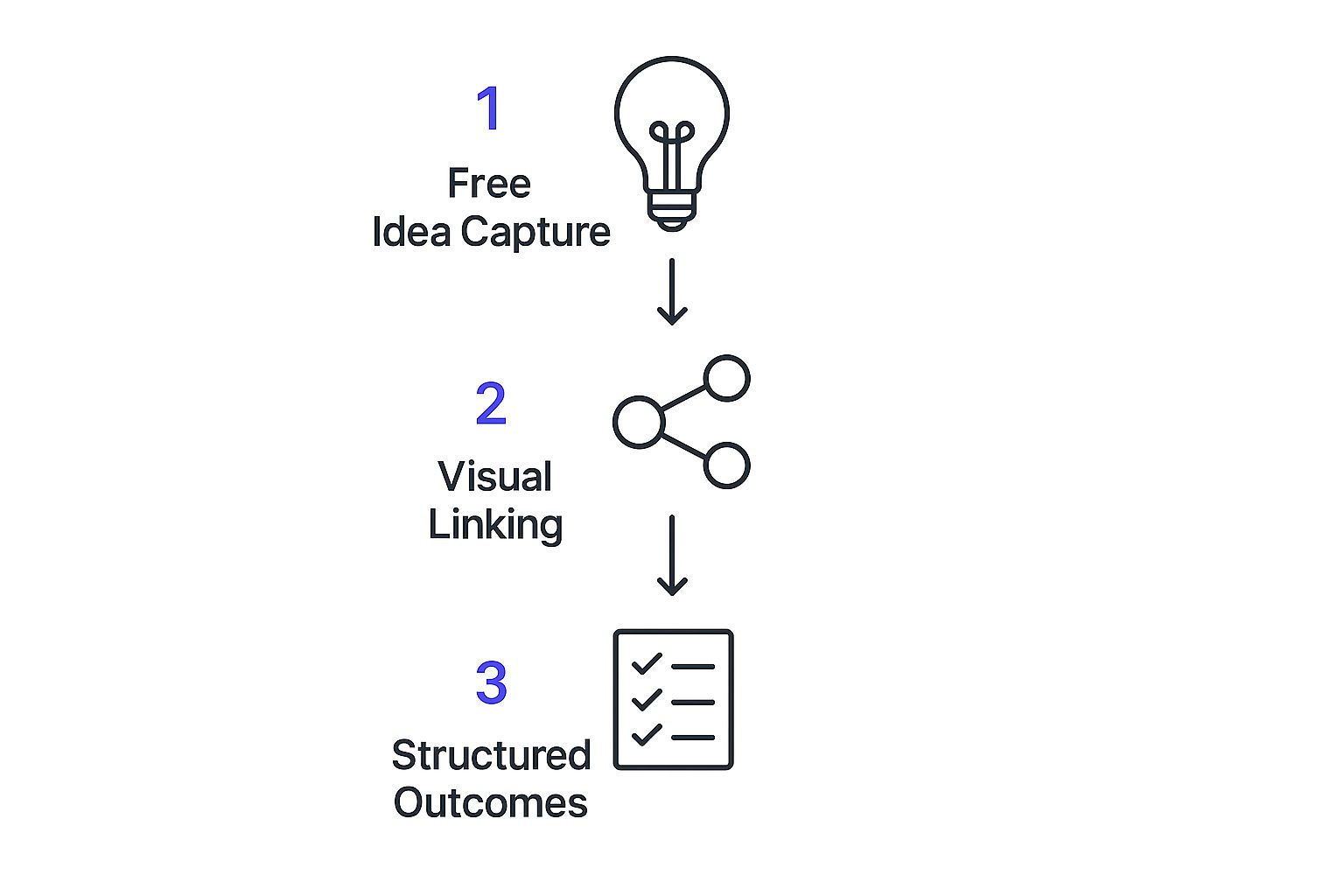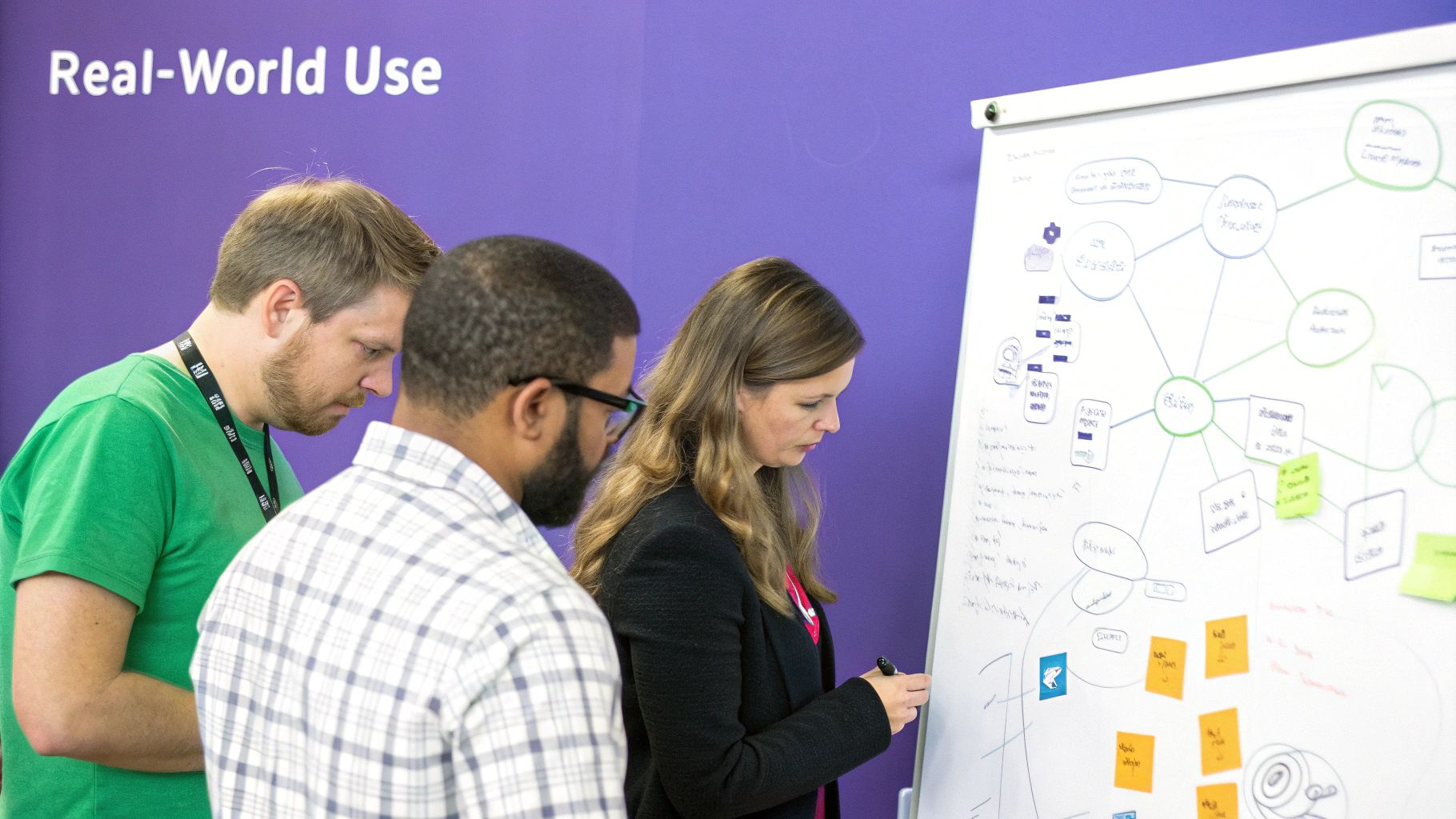A creativity mind map isn't just a brainstorming tool; it's a visual way to untangle your thoughts and kickstart new ideas from a single starting point. It works by branching out from one central concept into related topics and subtopics, a process that naturally mirrors how our brains make connections and push past creative blocks.
Unlocking Ideas with a Creativity Mind Map

Have you ever tried to build a complex puzzle without looking at the picture on the box? That’s what traditional brainstorming can feel like—a mess of disconnected ideas floating around in your head with no clear direction. A creativity mind map gives you that picture, providing a visual framework to connect those scattered thoughts into something that actually makes sense.
At its heart, it’s a simple diagram. You start with one concept and let related ideas grow outward from it, almost like a tree sprouting branches from its trunk. This structure is perfectly suited to how we think naturally, which is rarely in a straight line.
Why This Method Works
Unlike taking rigid, linear notes—which can accidentally shut down your creativity—a mind map encourages a free-flowing train of thought. It helps you bypass that inner critic that often dismisses ideas before they even have a chance to take shape.
This visual approach is powerful because it lets you:
- Capture Ideas Instantly: You can get concepts down on paper (or screen) fast, without getting bogged down by order or structure.
- See the Big Picture: A good mind map gives you a bird's-eye view of your entire project, making it much easier to spot patterns, themes, and gaps.
- Forge New Connections: When you visually link different thoughts, you start to see innovative relationships you would have totally missed otherwise.
A mind map transforms a chaotic spiral of thoughts into a clear, cohesive theme. It allows you to build a physical representation of your ideas, link them creatively, and establish a solid foundation for any project.
The Basic Structure
The real beauty of a creativity mind map is its simplicity. No matter how complicated the final map looks, every single one is built from the same basic parts. It all starts with one idea and expands from there.
The essential elements are pretty straightforward:
- A Central Topic: This is your core idea or the problem you're trying to solve. It goes right in the middle of the page.
- Main Branches: Think of these as the primary themes or categories that shoot directly out from the central topic.
- Sub-Branches: These are the smaller branches that extend from your main ones, adding all the important details and depth.
This simple but effective structure is the key to better brainstorming. While it shares some DNA with other visual tools, it's worth understanding the distinctions between concept maps and mind maps to pick the perfect one for what you're trying to achieve.
The Long History of Visual Thinking

While the creativity mind map might seem like a modern invention, the idea of thinking visually is anything but new. It’s a practice that’s been around for centuries, used by some of the brightest minds in history to organize their thoughts and connect the dots in new ways. This method isn't just a clever trick; it taps into the very wiring of how our brains work.
Long before we had software or even whiteboards, thinkers were sketching out their ideas. The practice of using diagrams to map out information has a history stretching back nearly two thousand years, with roots in the 3rd century. Philosophers like Porphyry of Tyros used diagrams that looked a lot like family trees to make sense of Aristotle's complex philosophical categories.
From Renaissance Notes to Modern Psychology
Jump forward a few centuries, and you’ll find this same visual approach in the hands of history's greatest innovators. It’s widely believed that Leonardo da Vinci used a form of mind mapping throughout his famous notebooks. He filled page after page with interconnected sketches and notes that branched out from a central idea, allowing him to explore everything from human anatomy to flying machines with incredible detail.
These early examples show us that thinking visually is just a natural human impulse. But it was British psychologist Tony Buzan who took these ancient instincts and shaped them into the technique we know today. In the 1960s, he officially coined the term "Mind Map" and spent years refining a system based on what we know about how the brain functions.
Tony Buzan wasn't just teaching people to draw pretty diagrams. He was building a tool designed to work with our brain's natural habits, not fight against them. His system was engineered to fire up both the logical left side of the brain and the creative right side at the same time.
How Buzan Engineered a Better Brainstorm
Buzan’s method was intentionally designed to break us out of the habit of taking notes in straight, boring lines. He created a simple set of rules to help boost creativity and make information stick. It turns out that how you capture your ideas matters just as much as the ideas themselves.
His core principles included:
- Starting with a central image to kickstart your imagination from the get-go.
- Using colors all over the map to help your visual memory and keep different themes separate.
- Writing a single keyword on each branch to let your mind make more connections.
- Drawing curved, organic lines instead of rigid, straight ones to create a more natural flow.
This structured approach to brainstorming and mind mapping turns a simple diagram into a serious thinking tool. When you understand its long history, you see that the creativity mind map isn't just another productivity fad. It’s a powerful technique, refined over centuries, that gets to the very heart of how we think.
How Mind Maps Unleash Your Creative Power
Think about a typical to-do list. It’s a straight line, rigid and predictable. That’s a great way to manage tasks, but it’s a terrible way to generate ideas. Creativity doesn't work in a straight line; it zigs, zags, and connects things in surprising ways.
A creativity mind map breaks free from that linear prison. It gives you a canvas to capture ideas as they flash into your mind, without worrying about order or structure right away. You’re free to just think.
This works so well because it mimics how our brains actually function—by making associations. Instead of a one-way street of thoughts, you get a sprawling web where any idea can spark another. This visual approach isn't just about making things look nice; it’s about actively helping you forge connections between concepts that might have seemed completely unrelated. And that’s where real innovation is born.
The infographic below shows just how simple and effective this flow can be, turning a jumble of raw ideas into a coherent plan.

As you can see, a mind map is a bridge, guiding you from messy, chaotic brainstorming to a clear and actionable result.
Seeing the Forest and the Trees
One of the biggest wins with mind mapping is finally getting that "big picture" view. When all your ideas are laid out in front of you, you can instantly spot patterns, notice gaps, and see how different pieces of the puzzle fit together.
This bird's-eye view brings an incredible amount of clarity. It activates both the logical and imaginative sides of your brain, helping you generate not just more ideas, but better ones. It becomes about quality and structure, not just a frantic brain dump.
The impact on cognitive performance is well-documented. The table below highlights some key statistics showing how mind mapping stacks up against more traditional approaches.
Mind Mapping Impact on Cognitive Performance
| Metric | Performance Boost with Mind Mapping | Source Highlight |
|---|---|---|
| Productivity | A boost of around 23% in overall productivity. | Mind Mapping Stats |
| Learning Efficiency | Up to 15% more efficient than traditional note-taking. | Mind Mapping Stats |
| Memory Retention | Improves memory of information by 10-15%. | Mind Mapping Stats |
These numbers aren't just abstract figures; they represent real gains in how effectively we can think, learn, and create. It's a clear indicator that aligning our tools with our natural cognitive processes pays off.
Activating Whole-Brain Thinking
The real magic of a creativity mind map is how it gets your entire brain involved. Old-school note-taking is very left-brained—it’s all about logic, lists, and linear order. A mind map invites the right hemisphere—the creative, visual, and intuitive side—to the party.
A mind map forces you to disentangle the chaotic spiral of thoughts in your head and form a clear, cohesive theme. It's a physical representation of your ideas that lets you establish a foundation for any project.
How does it do this? Through a few simple but powerful elements:
- Colors: Assigning different colors to branches helps you categorize information at a glance and fires up the creative centers of your brain.
- Images & Symbols: A quick doodle or an icon can anchor a concept in your mind far more effectively than words alone, tapping into our powerful visual memory.
- Keywords: Sticking to single keywords per branch forces your brain to make its own connections, sparking countless new associations and expanding your idea pool.
By bringing together words, colors, images, and spatial layout, you create a rich mental landscape that leads to deeper insights. This whole-brain approach helps you not only brainstorm but also develop structured, actionable plans. If you’re looking for other ways to get those innovative juices flowing, our guide on proven techniques for creativity offers more strategies that pair perfectly with mind mapping.
Building Your First Creativity Mind Map
Ready to jump in and try it yourself? Making your first creativity mind map is way easier than it sounds. You just need a blank space—a sheet of paper, a whiteboard, or a digital tool—and one single idea to get started.
It all kicks off with a strong central topic. This is the main question you're trying to answer or the problem you want to crack. Don't get hung up on perfection here; your gut feeling is usually right. Just write that idea down in the middle of your page and circle it. Think of it as the sun, with all your other ideas orbiting around it.
For instance, if you're trying to dream up a new marketing campaign, your central topic could be as simple as "Q3 Product Launch." Or, if you're a writer, maybe it's "Benefits of Remote Work."
Branching Out Your Main Ideas
With your central topic in place, it’s time to draw your main branches. These are the big-picture themes that flow directly from that core idea. I find that aiming for three to five main branches is the sweet spot—it keeps the map from getting too cluttered right off the bat.
From your center circle, draw a thick, curved line for each of these main ideas. Now, here’s a pro tip that makes all the difference: use a single keyword for each branch. This simple constraint forces your brain to work a little differently, sparking more connections than a long phrase would. Instead of "Analyze Competitor Strengths," just write "Competitors." It keeps you moving fast.
Adding Detail with Sub-Branches
Okay, this is where the magic really happens. Start adding smaller, thinner sub-branches off your main ones. These are for all the related details, stray thoughts, and follow-up questions that pop into your head. Let it all flow without judging or editing.
To really make this stage count, try these simple tricks:
- Use Colors and Images: Give each main branch and its offshoots a unique color. This helps your brain group ideas visually and keeps things interesting. A quick doodle or symbol next to a word can also lock it into your memory.
- Ask Probing Questions: As you add more detail, keep asking yourself questions. "Why is that important?" "What if we tried this?" "How would that work?" These little prompts are great for pushing past the obvious answers.
- Keep It Simple: Stick to the one-word-per-branch rule as much as you can. You’re aiming for a quick snapshot of an idea, not a complete sentence.
A mind map transforms a chaotic spiral of thoughts into a clear, cohesive theme. It allows you to build a physical representation of your ideas, link them creatively, and establish a solid foundation for any project.
This whole process guides you from a fuzzy, high-level concept down to a well-organized plan. If you’re ever stuck for inspiration, exploring different mind map ideas for various scenarios can give you a great head start. To take your brainstorming to the next level, you can also discover more powerful mind mapping techniques that really unlock visual thinking.
Putting Mind Maps into Action

The best way to really grasp the power of a creativity mind map is to see it work in the real world. This isn't just some abstract thinking exercise; it's a hands-on tool that delivers tangible results, whether you're in marketing or creative writing.
Let's walk through a couple of concrete examples. These stories show how real people take a chaotic mess of ideas and transform it into a clear, actionable plan—all with a single mind map.
Case Study: A Marketing Product Launch
Picture a marketing team gearing up to launch a new sustainable water bottle. They start with a blank whiteboard and write their central idea right in the middle: "Eco-Bottle Launch." From that single point, the main branches begin to grow.
- Target Audience: This branch quickly sprouts into smaller limbs like "Hikers," "Students," and "Office Workers." Each of these gets its own notes detailing their specific values and what problems they need solved.
- Key Messaging: Here, the team brainstorms the core message. Keywords like "Durable," "BPA-Free," and "Planet-Friendly" pop up, and they start linking them back to the different audience profiles.
- Channels: This part of the map explores where to find their customers. It branches out into "Social Media," "Influencers," and "Retail Partners."
- Launch Event: Ideas for a launch party get their own section, with sub-branches for "Venue," "Guest List," and "Activities."
As they map everything out visually, the team starts seeing connections they would have otherwise missed. They notice that the "Hikers" group under Target Audience is a perfect match for the "Outdoor Influencers" they listed under Channels. That single insight, sparked by the visual layout, ends up shaping their entire strategy. The result is a much sharper, more effective campaign than a traditional, linear document could ever produce.
The mind map becomes the project's single source of truth. It turns a pile of disjointed brainstorming notes into a cohesive strategy where every piece supports the main goal, ensuring nothing falls through the cracks.
Case Study: A Novelist Outlining a Story
Now, let's switch gears to a writer staring down a bad case of writer's block. They have a brilliant idea for a story but can't seem to nail down the structure. So, they start a creativity mind map with the novel's working title at its heart.
The main branches become the foundational pillars of the story:
- Plot Points: This expands into major story beats like the "Inciting Incident," the "Midpoint Twist," and the "Climax." Each of these points gets its own sub-branches to flesh out the details of what happens.
- Characters: Every main character gets a primary branch, which then breaks down into their "Motivations," "Flaws," and "Relationships" with others.
- Themes: This branch is all about the deeper meaning. It explores concepts like "Betrayal," "Redemption," and "Loss."
As the writer connects a character's "Flaw" to a specific "Plot Point," brand new story ideas start to surface. They might suddenly realize that the "Midpoint Twist" directly challenges a character's core "Motivation," creating a layer of rich, natural conflict. The mind map doesn't just organize the story; it helps build it by revealing narrative threads that were hidden before. It’s a way to untangle that chaotic spiral of thoughts and turn a complex web of ideas into a solid, compelling plot.
Supercharging Your Mind Maps with AI
While a classic pen-and-paper creativity mind map is a powerful tool on its own, technology has given us an incredible new partner: Artificial Intelligence. Think of AI-powered mind mapping tools as a creative co-pilot, there to help you blast through mental blocks and discover ideas you might have otherwise missed.
It’s like a duet between your own intuition and the processing power of a machine. You bring the initial spark—that core concept at the heart of your map—and the AI helps you build it into a roaring fire. It can suggest new branches, find hidden connections, and flesh out your briefest thoughts, turning a single keyword into a whole new path of exploration.
Your Creative Co-Pilot
AI does more than just put your map on a screen; it actively helps build it. This partnership can be a real game-changer when you feel stuck. Instead of staring at a blank space, you’ve got an assistant ready to offer a fresh angle.
Here’s how AI steps in to help:
- Automated Branch Generation: The AI looks at your central topic and existing ideas to propose relevant new sub-topics. This saves a ton of time and sparks connections you hadn't considered.
- Thematic Clustering: It can automatically group related ideas from different parts of your map, revealing patterns and overarching themes that weren't obvious at first glance.
- Idea Expansion: Just feed the AI a simple concept. It can fire back with questions, counterarguments, or related facts to help you dig deeper.
This isn't about replacing human creativity—it's about enhancing it. AI handles the heavy lifting of organizing and expanding, which frees you up to do the truly innovative thinking.
This approach gives you the best of both worlds. You keep complete creative control, while the AI acts as a tireless brainstorming partner that’s always ready to push your session a little further. Digging into how AI can help us be more creative really shows just how powerful this combination can be.
AI can also pull in and organize information from all sorts of places to feed your mind map. For instance, understanding a tool mentioned in this Your Guide to Video Transcription AI shows how you could pull key ideas directly from a video and instantly add that rich data to your creative process.
A Few Common Questions About Mind Mapping
As you start getting into creativity mind maps, a few questions inevitably pop up. I’ve heard them all before, and getting them sorted out from the get-go will make the whole process feel a lot more natural and effective.
Mind Map vs. Concept Map: What’s the Difference?
This is probably the most common question I get. Think of it this way: a creativity mind map is like a starburst. It all explodes outward from a single, central idea, making it perfect for free-flowing brainstorming sessions where you're just letting your thoughts run wild.
A concept map, on the other hand, is more like a spider's web. It connects several different ideas to show how they relate to each other. It’s less about generating new ideas and more about organizing what you already know.
How Many Branches Should I Have?
People often worry about getting the structure "right." Is there a magic number of branches? Not really, but I've found a good rule of thumb is to start with three to five main branches coming off your core topic.
This gives you a solid foundation without making things feel too chaotic right away. From those main branches, feel free to add as many smaller offshoots as you need. The key is to keep it readable.
A great pro-tip: If one of your branches starts getting too cluttered and confusing, just turn it into the central topic of a brand new mind map. This is a simple way to keep your thoughts organized as they grow more complex.
Can This Actually Work for a Team?
Absolutely! Mind mapping is a fantastic tool for group brainstorming. Get everyone around a whiteboard or pull up a shared digital canvas. As people throw out ideas, you can add them as new branches in real-time.
It’s a powerful way to create a shared visual of the group’s collective brainpower, and it makes sure everyone’s contribution is seen and valued.
Ready to transform your team's brainstorming sessions? Bulby provides the AI-powered guidance and structure to turn scattered thoughts into brilliant, actionable ideas. Start your journey toward more effective creativity at https://www.bulby.com.

